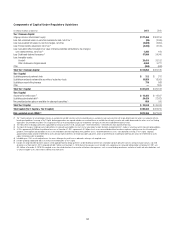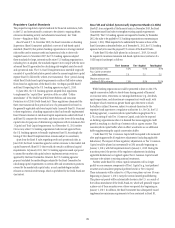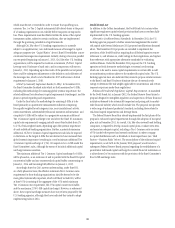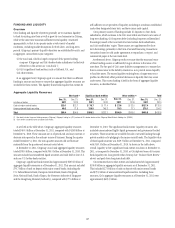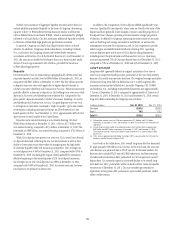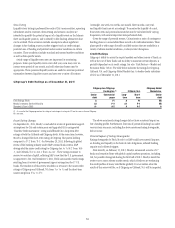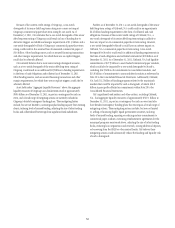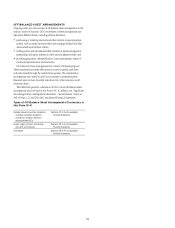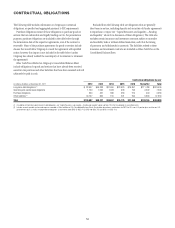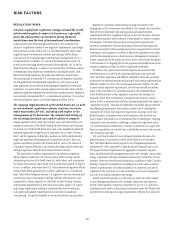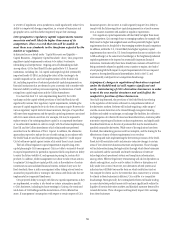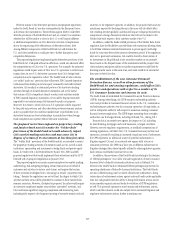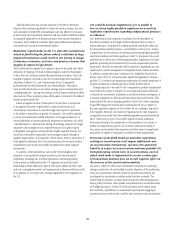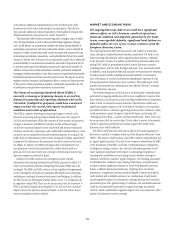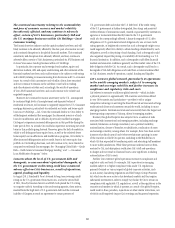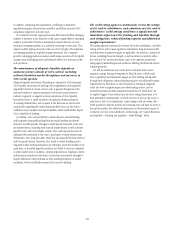Citibank 2011 Annual Report Download - page 73
Download and view the complete annual report
Please find page 73 of the 2011 Citibank annual report below. You can navigate through the pages in the report by either clicking on the pages listed below, or by using the keyword search tool below to find specific information within the annual report.
51
Stress Testing
Liquidity stress testing is performed for each of Citi’s major entities, operating
subsidiaries and/or countries. Stress testing and scenario analyses are
intended to quantify the potential impact of a liquidity event on the balance
sheet and liquidity position, and to identify viable funding alternatives that
can be utilized. These scenarios include assumptions about significant
changes in key funding sources, market triggers (such as credit ratings),
potential uses of funding and political and economic conditions in certain
countries. These conditions include standard and stressed market conditions
as well as firm-specific events.
A wide range of liquidity stress tests are important for monitoring
purposes. Some span liquidity events over a full year, some may cover an
intense stress period of one month, and still other time frames may be
appropriate. These potential liquidity events are useful to ascertain potential
mismatches between liquidity sources and uses over a variety of horizons
(overnight, one week, two weeks, one month, three months, one year),
and liquidity limits are set accordingly. To monitor the liquidity of a unit,
those stress tests and potential mismatches may be calculated with varying
frequencies, with several important tests performed daily.
Given the range of potential stresses, Citi maintains a series of contingency
funding plans on a consolidated basis as well as for individual entities. These
plans specify a wide range of readily available actions that are available in a
variety of adverse market conditions, or idiosyncratic disruptions.
Credit Ratings
Citigroup’s ability to access the capital markets and other sources of funds, as
well as the cost of these funds and its ability to maintain certain deposits, is
partially dependent on its credit ratings. See also “Risk Factors—Market and
Economic Risks” below. The table below indicates the ratings for Citigroup,
Citibank, N.A. and Citigroup Global Markets Inc. (a broker-dealer subsidiary
of Citi) as of December 31, 2011.
Citigroup’s Debt Ratings as of December 31, 2011
æ
Citigroup Inc./Citigroup
Funding Inc. (1) Citibank, N.A.
Citigroup Global
Markets Inc.
Senior
debt
Commercial
paper
Long-
term
Short-
term
Senior
debt
&ITCHæ2ATINGSæ&ITCH A F1 A F1 NR
-OODYSæ)NVESTORSæ3ERVICEæ-OODYS A3 P-2 A1 P-1 NR
3TANDARDææ0OORSæ30 A- A-2 A A-1 A
æ !SæAæRESULTæOFæTHEæ#ITIGROUPæGUARANTEEæTHEæRATINGSæOFæANDæCHANGESæINæRATINGSæFORæ#&)æAREæTHEæSAMEæASæTHOSEæOFæ#ITIGROUP
.2æ .OTæRATED
Recent Rating Changes
On September 21, 2011, Moody’s concluded its review of government support
assumptions for Citi and certain peers and upgraded Citi’s unsupported
“Baseline Credit Assessment” rating and affirmed Citi’s long-term debt
ratings at both the Citibank and Citigroup levels. At the same time, however,
Moody’s changed the short-term rating of Citigroup (the parent holding
company) to ‘P-2’ from ‘P-1’. On November 29, 2011, following its global
review of the banking industry under S&P’s revised bank criteria, S&P
downgraded the issuer credit rating for Citigroup Inc. to ‘A-/A-2’ from ‘A/A-
1’, and Citibank, N.A. to ‘A/A-1’ from ‘A+/A-1’. These ratings continue to
receive two notches of uplift, reflecting S&P’s view that the U.S. government
is supportive to Citi. On December 15, 2011, Fitch announced revised ratings
resulting from its review of government support assumptions for 17 U.S.
banks. The resolution of this review resulted in a revision to the issuer credit
ratings of Citigroup and Citibank, N.A. from ‘A+’ to ‘A’ and the short-term
issuer rating from ‘F1+’ to ‘F1’.
The above mentioned rating changes did not have a material impact on
Citi’s funding profile. Furthermore, forecasts of potential funding loss under
various stress scenarios, including the above mentioned rating downgrades,
did not occur.
Potential Impact of Ratings Downgrades
Ratings downgrades by Fitch, Moody’s or S&P could have material impacts
on funding and liquidity in the form of cash obligations, reduced funding
capacity and collateral triggers.
Most recently, on February 15, 2012, Moody’s announced a review of 17
banks and securities firms with global capital markets operations, including
Citi, for possible downgrade during the first half of 2012. Moody’s stated this
review was to assess adverse market trends, which it believes are weakening
the credit profiles of many rated banks globally. It is not certain what the
results of this review will be, or if Citigroup or Citibank, N.A. will be impacted.



